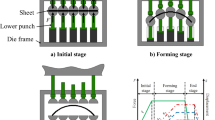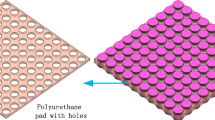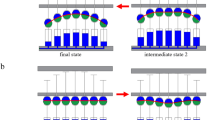Abstract
In this paper, a new process of multi-point forming with individually controlled force-displacement (MPF-ICFD) is presented to reduce the springback in the traditional multi-point forming (MPF). An experimental setup was designed and manufactured, and the contrast experiment was conducted to investigate the differences between the traditional MPF and the proposed MPF-ICFD. Furthermore, the stress state and springback mechanism in both processes were analyzed with the plastic forming theory. The differences in springback were also investigated with 1060 aluminum alloy and Q 295 steel. The results showed that the specimens in MPF-ICFD presented an excellent deformation uniformity and are consistent with the target profile. The springback magnitude of 1060 aluminum alloy is 34.63% in MPF while 7.51% in MPF-ICFD, and the springback magnitude of Q 295 steel is 31.16% in MPF while 17.02% in MPF-ICFD. The results demonstrate that the springback can be strongly inhibited by MPF-ICFD.
Similar content being viewed by others
References
Li MZ, Cai ZY, Sui Z, Han QG (2002) Multi-point forming technology for sheet metal. J Mater Proces Technol 129(1):333–338
Daniel FW, Jean FH, John MP (2003) Using reconfigurable tooling and surface heating for incremental forming of composite aircraft parts. J Manuf Sci Eng 125(2):333–343
Se YH, Jang HL, Yong SY, Yoo MJ (2010) Springback adjustment for multi-point forming of thick plates in shipbuilding. Comput Aided Des 42(11):1001–1012
Peng JW, Li WD, Han JQ, Wan M, Meng B (2016) Kinetic locus design for longitudinal stretch forming of aircraft skin components. Int J Adv Manuf Technol 86(9):3571–3582. doi:10.1007/s00170-016-8456-0
Edwin H, Robert CS, John MP (2002) Design and test of a reconfigurable forming die. J Manuf Process 4(1):77–85
Daniel FW, David EH (1998) Design and analysis of reconfigurable discrete dies for sheet metal forming. J Manuf Syst 17(6):436–454
Liu CG, Li MZ, Fu WZ (2008) Principles and apparatus of multi-point forming for sheet metal. Int J Adv Manuf Technol 35(35):1227–1233
Liu YJ, Li MZ, Ju FF (2016) Research on the process of flexible blank holder in multi-point forming for spherical surface parts. Int J Adv Manuf Technol 1–8. doi: 10.1007/s00170–016–9198-8
Le L, Young HS, Seong CH, Beom SK, Jeong K (2010) Numerical simulations on reducing the unloading springback with multi-step multi-point forming technology. Int J Adv Manuf Technol 48(1):45–61
Zhang QF, Cai ZY, Zhang Y, Li MZ (2013) Springback compensation method for doubly curved plate in multi-point forming. Mater Des 47(9):377–385
Cai ZY, Wang SH, Li MZ (2008) Numerical investigation of multi-point forming process for sheet metal: wrinkling, dimpling and springback. Int J Adv Manuf Technol 37(9):927–936
Behnam D, Behrooz ZD (2014) Assessment of forming parameters influencing spring-back in multi-point forming process: a comprehensive experimental and numerical study. Mater Des 59(6):103–114
Bahloul R, Elechi SB, Potiron A (2006) Optimisation of springback predicted by experimental and numerical approach by using response surface methodology. J Mater Process Technol 173(1):101–110
Wang SH, Cai ZY, Li MZ, Lan YW (2012) Numerical simulation on the local stress and local deformation in multi-point stretch forming process. Int J Adv Manuf Technol 60(9):901–911
Wang Y, Li MZ (2014) Research on three-dimensional surface parts in multi-gripper flexible stretch forming. Int J Adv Manuf Technol 71(9):1701–1707
Daniel FW, Jayant L, Daniel RK (1998) Development of a reconfigurable tool for forming aircraft body panels. J Manuf Syst 17(4):287–296
Simona S, Mary CB (2001) A finite element based die design algorithm for sheet-metal forming on reconfigurable tools. J Eng Mater Technol 123(4):489–495
Yong TI, Daniel FW, Robert CS, John MP (2000) A comparison of pin actuation schemes for large-scale discrete dies. J Manuf Process 2(4):247–257
Pahl KJ (1997) New developments in multi-point die-cushion technology. J Mater Process Technol 71(1):168–173
Zhang Q, Wang ZR, Dean TA (2008) The mechanics of multi-point sandwich forming. Int J Mach Tools Manuf 48(12):1495–1503
Zhang Q, Wang ZR, Dean TA (2007) Multi-point sandwich forming of a spherical sector with tool-shape compensation. J Mater Process Technol 194(1):74–80
Zhang Q, Dean TA, Wang ZR (2006) Numerical simulation of deformation in multi-point sandwich forming. Int J Mach Tools Manuf 46(7):699–707
Song AP, Wang LT, Chen T, Li LY (2008) The multi-point pressing and forming technology and its stamping process. J Plasticity Eng 15(5):108–114
Liu ZW, Li MZ, Han QG (2012) Multi-point forming with wrinkle resistance function and its forming accuracy. J Mech Eng 48(12):56–61
Li MZ, Liu YH, Su SZ, Li GQ (1999) Multi-point forming: a flexible manufacturing method for a 3-d surface sheet. J Mater Process Technol 87(1):277–280
Peng LF, Lai XM, Li MZ (2006) Transition surface design for blank holder in multi-point forming. Int J Mach Tools Manuf 46(46):1336–1342
Cai ZY, Li MZ (2002) Mulit-point forming of three-dimensional sheet metal and the control of the forming process. Int J Press Vessel Pip 79(4):289–296
Luo YX, Yang WM, Liu ZF, Wang YQ, Du RX (2016) Numerical simulation and experimental study on cyclic multi-point incremental forming process. Int J Adv Manuf Technol 85(5):1249–1259
Liu W, Chen YZ, Xu YC, Yuan SJ (2016) Evaluation on dimpling and geometrical profile of curved surface shell by hydroforming with reconfigurable multipoint tool. Int J Adv Manuf Technol 86(5):2175–2185. doi:10.1007/s00170-015-8264-y
Heo SC, Seo YH, Ku TW, Kang BS (2010) A study on thick plate forming using flexible forming process and its application to a simply curved plate. Int J Adv Manuf Technol 51(1):103–115
Author information
Authors and Affiliations
Corresponding author
Rights and permissions
About this article
Cite this article
Jia, Bb., Wang, WW. New process of multi-point forming with individually controlled force-displacement and mechanism of inhibiting springback. Int J Adv Manuf Technol 90, 3801–3810 (2017). https://doi.org/10.1007/s00170-016-9709-7
Received:
Accepted:
Published:
Issue Date:
DOI: https://doi.org/10.1007/s00170-016-9709-7




